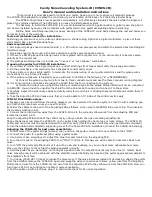
IonPac TCC-LP1, TCC-ULP1, and TCC-XLP1
Product Manual
Page 4 of 17
Doc. No. 034973-06
©2005 DIONEX
September 2005
1.
INTRODUCTION
The IonPac® Trace Cation Concentrator Low Pressure (TCC-LP1, P/N 046027), Ultra Low Pressure (TCC-ULP1, P/N
063783), and Extremely Low Pressure (TCC-XLP1, P/N 063889) Columns are designed primarily for high purity water
analysis. The function of the columns is to strip ions from a measured volume of a relatively clean aqueous sample matrix.
This process “concentrates” the desired analyte species onto the columns leading to a lowering of detection limits by 2-5
orders of magnitude. The unique advantage of the columns to the analytical chemist is the capability of performing routine
Low Pressure, Ultra Low Pressure, and Extremely Low Pressure Trace analyses of sample matrix ions at µg/L levels without
extensive and laborious sample pretreatment.
The TCC-LP1, TCC-ULP1, and TCC-XLP1 columns are packed with a 20 µm styrene/divinylbenzene copolymer that is
grafted to yield a resin with carboxylate functional groups. Due to its highly cross-linked structure, the resin is solvent
compatible. The capacity of the TCC-LP1, TCC-ULP1, and TCC-XLP1 is 260 µeq/column with a void volume of
approximately 250 µL. The physical rigidity of this resin allows the TCC-LP1, TCC-ULP1, and TCC-XLP1 to be used at
pressures up to 3,000 psi (20.68 MPa). The TCC-LP1, TCC-ULP1, and TCC-XLP1 can be readily converted between the
acid and the salt form without significant changes in the operating pressure.
The recommended maximum flow rate is 5 mL/min. The back pressure generated by the TCC-LP1 is less than 70 psi (0.48
MPa) at 1 mL/min, the TCC-ULP1 is less than 45 psi (0.31 MPa) at 1 mL/min, and the TCC-XLP1 is less than 30 psi (0.21
MPa) at 1 mL/min. The large resin particle size (20 µm) in the TCC-LP1, TCC-ULP1, and TCC-XLP1 makes it possible to
do manual injections onto the concentrator. Syringes with up to 3 mL capacities can be used to manually push samples
through the TCC-LP1. It takes approximately 1 minute to manually push 3 mL of sample through the TCC-LP1, TCC-ULP1,
and TCC-XLP1 columns.
The TCC-LP1, TCC-ULP1, and TCC-XLP1 columns can be used with methanesulfonic acid, sulfuric acid, and hydrochloric
acid eluents, with or without solvent, to concentrate samples on 5-mm, 4-mm, 3-mm, or 2-mm analytical systems.
This manual assumes that you are familiar with the installation and operation of the DIONEX Ion Chromatograph (IC) and
the suppressor. If you do not understand the operation of the system, take the time to familiarize yourself with the various
system components before beginning an analysis. The TCC-LP1, TCC-ULP1, and TCC-XLP1 have 10-32 threaded PEEK
end fittings for use with ferrule/bolt liquid line fittings. If you find it necessary to install a component with 1/4-28 ports and
therefore need to obtain or make one or more transition lines between 10-32 and 1/4-28 threaded ThermoFlare ports,
DIONEX recommends the use of Tefzel® liquid lines with a PEEK ferrule/bolt fitting on one end and a 1/4-28 ThermoFlare
fitting on the other end. See, “DIONEX Liquid Line Fittings,” for detailed instructions on purchasing or making these lines.
Assistance is available for any problem during the shipment or operation of Dionex instrumentation, columns, and
consumables through the Dionex North America Technical Call Center at 1-800-DIONEX-0 (1-800-346-6390) or
through any of the Dionex Offices listed in “Dionex Worldwide Offices” on the Dionex Reference Library CD-ROM.
Summary of Contents for IonPac TCC Series
Page 1: ...IonPac TCC...



































